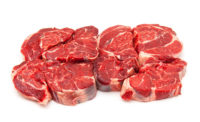Most frequently, X-ray and metal detection are used on final packaged product, or very close to the packaging step, in order to be at the last possible point for checking for foreign material prior to going to the consumer.
Many processors, though, such as OSI Group, in Aurora, Ill., have established multiple hurdles to prevent and detect foreign material within their product streams.
“We use a two-stage combo dumper in grinding, so when the combo is tipped, the pallet stays in position and does not move over the product,” explains Sharon Birkett, vice president North American quality and food protection. “This prevents any foreign material that may be on the pallet from entering the product stream.”
OSI also has a strict preventive maintenance program to review the condition of equipment that could introduce foreign material into the product stream. “We have eliminated the use of glass and hard plastic wherever possible to prevent any pieces from entering the stream,” Birkett says. “In areas where they are necessary, such as gage covers or site glasses, we install those components away from exposed product and conduct frequent, regularly scheduled inspections.”
OSI also has implemented the use of X-ray to reduce bone instances. In one facility, the company X-rays trimmings before grinding. “This provides excellent feedback to the raw material vendor about the product that was delivered to us,” Birkett says. “In other facilities, we utilize X-ray after grinding and after the finished product is frozen. In addition to the use of X-ray for bone, we also have a very strong vendor management program that gives real-time feedback to our vendors on any other raw-material defects.”
The initiatives in place at Ruiz Food Products Inc., Dinuba, Calif., to prevent wood chips, glass, plastic, bone and other materials from entering the product stream are categorized by external and internal policies and procedures. Vendor compliance is monitored by the company’s dedicated staff who, through its own audits, qualifies its vendors. Ruiz Foods also has inter-departmental procedures for areas such as operations, quality assurance, maintenance and sanitation.
“Each department has a very specific protocol in place,” says Rachel Cullen, Ruiz Food’s president and chief executive officer. “Some of the protocols are universal for every product and flavor. Other protocols, like implementing the use of in-line filters and screens, even guards and lids, are specific to products or flavors.”
Ruiz Foods’ internal prevention sequence begins with a sanitation wash-down, followed by a complete quality assurance inspection. Equipment is then activated preflight, i.e., without any ingredients. Preflights are followed by sanitation and quality assurance verification. Performance metrics are maintained as a key performance indicator, Cullen says.
Multiple hurdles
Team members play a critical role in the prevention of foreign materials from entering the product stream.
“Training is paramount and includes annual GMP, food defense, allergen and HACCP compliance training sessions,” Ruiz Foods’ Cullen says. “Then on a monthly basis, two topics specific to safety are reviewed in depth — for example, foreign material control and foreign material reporting. Team members are also trained to inspect the equipment they use prior to using, notify their supervisor if they have any questions or suspicions, be careful with the way all materials are handled and maintain a heightened state of awareness.”
For OSI, food safety is the responsibility of every employee as well. Each employee can identify and remove any object that is at risk of falling into the product stream; for instance, picking up loose nuts or bolts they may see near the production line.
“Once trained on the expectation, any employee can stop a line if they observe the presence of foreign material,” Birkett says. “Employees are also responsible for housekeeping of their work area and the equipment that they operate. They maintain them in good working condition to prevent foreign objects from becoming a problem.”
While X-ray and metal detection system are most useful in detecting foreign material in the product stream, Ruiz Foods begins its detection with the vendor, requiring key vendors to pass raw materials through a metal detection or X-ray screening prior to delivery. Ruiz Foods then passes finished packages through metal detection or X-ray. Performance is verified on a strict frequency, Cullen says.
OSI also uses X-ray and metal detectors in multiple places in the process with a best practice to use both systems in some processes. “Of course, it matters what type of objects you are attempting to detect,” OSI’s Birkett says. “The devices behave differently depending on the state the product is in and the type of material you want to detect. For bone, it makes sense that we have a better opportunity to remove it from the process when the bone fragment is larger or intact, like at the beginning of the process, before any breaking or grinding occurs.”
It is important also to guarantee that the finished product is free of foreign materials. In this case, OSI uses a detection system for one final check at the end of the process to ensure the product does not pose a food safety risk, Birkett says.
In addition, OSI is using state-of-the-art X-ray technology for scanning raw material trimmings before grinding. “This process enables faster and more accurate feedback to raw material vendors on findings like bone or bird shot,” Birkett says. “With the technology at the beginning of process, OSI can prevent equipment damage that could result from foreign objects within the raw material received from vendors. It can also prevent bones from being ground smaller and, thus, much harder to detect.”
Donna Schaffner, associate director of food safety, quality assurance and training for Rutgers Food Innovation Center, in Bridgeton, N.J., expects as more small- to medium-size companies send people to the FDA’s new Preventive Controls for Human Food – Qualified Individual training, they will decide to purchase foreign-material detection equipment where they had not been using that type equipment before, simply because they were not aware of the potential repercussions and liability of not checking their product for foreign material. “I expect more of the processors already using foreign material detection equipment will soon be upgrading to newer models that offer more automated recording of events and that make it easier to comply with records requirements of their third party audits,” she says.
New technologies are being implemented in foreign object detection systems for processors. For example, new capability built into the metal detector equipment for data acquisition systems allows easier tracking of the number of packages that passed through the machine and the number of packages rejected by the machine, Schaffner says. In addition, 3-D-type imaging gives better clues as to what size and type of metal was in the rejected product, which is now downloadable through a USB port for printing reports that satisfy the requirements for GFSI-compliant third-party audits. This makes the machine more attractive to overworked food safety and quality assurance personnel, she says.
Offering the addition of other industry improvements, such as wheels made from antimicrobial materials as an added feature for foreign material detection machinery that is wheeled out of place for cleaning or for use on different processing lines, can make a particular machine more attractive to food safety-conscious professionals working in the food processing environment as well, Schaffner says.
Detection of materials other than metal that have a density too close to that of the food material to be distinguished easily by X-ray still poses a challenge. “Thin slivers of glass or brittle plastic are still undetectable for most if not all foreign material detection equipment, and even thin pieces of metal wire are a serious challenge for most foreign material detection equipment, Schaffner says.
Certain companies are putting more sophisticated computer logic systems into their equipment, and adding additional beams at different angle configurations in order to increase the probability of finding those difficult-to-find objects, but the cost is still too high for many food processors to consider purchasing, as long as less-expensive models are still considered good enough.
“Many small- to medium-sized companies just do not see the return on investment from paying so much more for a machine with greater detection capability, if they rarely, if ever, receive customer complaints regarding foreign material in their products,” Schaffner says.
Schaffner predicts companies making this type equipment will continue to improve their detection capability and ease of data communication to the user. She also believes equipment companies will develop more and better automated systems such as wirelessly transmitting the data from the detection equipment directly to quality assurance managers’ computers or hand-held devices. NP





Report Abusive Comment